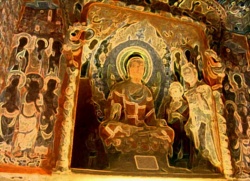Difference between revisions of "Samghavarman"
(Created page with "thumb|250px| <poem> Samghavarman (Skt) (1) 康僧鎧 (n.d.) ( Jpn Kosogai) A monk and a translator of Buddhist scriptures active in ...") |
|||
| Line 5: | Line 5: | ||
A [[monk]] and a translator of [[Buddhist scriptures]] active in [[China]] during the third century. Described by some accounts as a native of [[India]], another [[view]] holds that he was a native of a {{Wiki|kingdom}} known by the {{Wiki|Chinese}} as [[K'ang-chy]] that included the city of {{Wiki|Samarkand}} and its neighboring areas in {{Wiki|Central Asia}}. The {{Wiki|Chinese}} [[name]] for [[Samghavarman]] is [[K'ang-seng-k'ai]]; [[K'ang]] is a [[name]] generally [[thought]] to have been given to those from the [[K'ang-chy]] kingdom.In 252 he went to {{Wiki|Lo-yang}} in the [[Wikipedia:Cao Wei|Wei kingdom]], one of the {{Wiki|three kingdoms}} in [[China]] at the [[time]], and settled at [[Pai-ma-ssu]] temple.According to a [[Buddhist]] source, he translated the [[Buddha]] [[Infinite Life Sutra]] and other [[sutras]] into {{Wiki|Chinese}}. Some believe, however, that the [[Buddha Infinite Life Sutra]] was translated in a later period. | A [[monk]] and a translator of [[Buddhist scriptures]] active in [[China]] during the third century. Described by some accounts as a native of [[India]], another [[view]] holds that he was a native of a {{Wiki|kingdom}} known by the {{Wiki|Chinese}} as [[K'ang-chy]] that included the city of {{Wiki|Samarkand}} and its neighboring areas in {{Wiki|Central Asia}}. The {{Wiki|Chinese}} [[name]] for [[Samghavarman]] is [[K'ang-seng-k'ai]]; [[K'ang]] is a [[name]] generally [[thought]] to have been given to those from the [[K'ang-chy]] kingdom.In 252 he went to {{Wiki|Lo-yang}} in the [[Wikipedia:Cao Wei|Wei kingdom]], one of the {{Wiki|three kingdoms}} in [[China]] at the [[time]], and settled at [[Pai-ma-ssu]] temple.According to a [[Buddhist]] source, he translated the [[Buddha]] [[Infinite Life Sutra]] and other [[sutras]] into {{Wiki|Chinese}}. Some believe, however, that the [[Buddha Infinite Life Sutra]] was translated in a later period. | ||
| − | (2)[ | + | (2)[[僧伽跋摩]](n.d.) ( Jpn [[Sogyabatsuma]]): A [[monk]] from [[India]] who traveled to [[Chien-k'ang]] in [[China]] in 433 where he conferred the [[Buddhist]] [[precepts]] upon hundreds of {{Wiki|priests}} and [[nuns]]. He also translated five [[Buddhist]] works, including The Supplement to "The [[Heart of the Abhidharma]]." In 442 he left [[China]] and returned to [[India]] by sea. |
</poem> | </poem> | ||
{{R}} | {{R}} | ||
| − | [http:// | + | [http://www.sgilibrary.org/search_dict.php?id=1895 www.sgilibrary.org] |
Latest revision as of 19:35, 20 September 2013
Samghavarman (Skt) (1)
康僧鎧 (n.d.) ( Jpn Kosogai)
A monk and a translator of Buddhist scriptures active in China during the third century. Described by some accounts as a native of India, another view holds that he was a native of a kingdom known by the Chinese as K'ang-chy that included the city of Samarkand and its neighboring areas in Central Asia. The Chinese name for Samghavarman is K'ang-seng-k'ai; K'ang is a name generally thought to have been given to those from the K'ang-chy kingdom.In 252 he went to Lo-yang in the Wei kingdom, one of the three kingdoms in China at the time, and settled at Pai-ma-ssu temple.According to a Buddhist source, he translated the Buddha Infinite Life Sutra and other sutras into Chinese. Some believe, however, that the Buddha Infinite Life Sutra was translated in a later period.
(2)僧伽跋摩(n.d.) ( Jpn Sogyabatsuma): A monk from India who traveled to Chien-k'ang in China in 433 where he conferred the Buddhist precepts upon hundreds of priests and nuns. He also translated five Buddhist works, including The Supplement to "The Heart of the Abhidharma." In 442 he left China and returned to India by sea.
